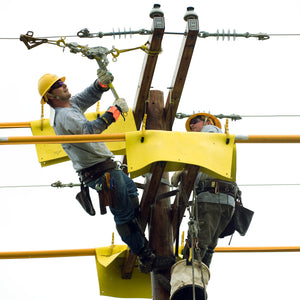Lineman Disaster Recovery Stories: Microburst

Storms and natural disasters happen throughout the United States on a regular basis. Hurricanes that impact the East Coast and Gulf of Mexico are among the most destructive natural disasters, and they can knock out electrical power to huge areas. However, hurricanes aren’t the only destructive storms that knock out electrical power. Many other kinds of storms can also lead to widespread power outages, and they also require major recovery efforts.
Linemen are crucial to overall recovery efforts, because their work in restoring the electrical grid provides electrical power to other emergency responders. I had the chance to talk to several linemen about their experiences in recovery efforts after hurricanes and other natural disasters. So far in this series, we have covered the stories of Matt, a lineman from Colorado, and DJ, a lineman from Virginia. This story comes from Max, a lineman from Arizona.
Max—Salt River Project
Max Germain is a lineman working for the Salt River Project in Phoenix, Arizona. If you ask him, Max will tell you that hurricanes are only one of the many kinds of natural disasters that linemen like himself have to clean up after. Arizona might not see hurricanes like those on the East Coast, but it does deal with microburst storms that can take a heavy toll on power and utilities.
Microbursts are severe weather events caused by intense downdrafts, which can be produced by thunderstorms under some conditions. During a thunderstorm, large pockets of cold air can form. As the air cools, it becomes much denser than the warm air surrounding it, and it plummets toward the ground below the storm.
When the cold, dense air reaches the ground, it expands outward in a radial pattern centered on the point of impact. The impact produces straight-line winds in all directions that can reach 150 mph, the same intensity as an F2 tornado. Even with their short duration, microbursts produce enough wind to cause extensive damage to the electrical grid.
Max told me about one particularly powerful stormfront he remembers. The storm created several microbursts that caused significant damage to the surrounding area, tearing shingles off roofs, toppling trees, and taking down power lines. The damage caused to electrical transmission systems produced significant power loss in Phoenix and the surrounding areas, so Max and the other crews of linemen had a huge task on their hands to restore power to full capacity in the area.
One of the first tasks they had to tackle was to construct temporary Lindsey towers. These towers can be put up quickly, which allows power lines to be set up while the linemen repair the permanent towers. As soon as the Lindsey towers were in place, the power lines could be repaired to get electricity back to the surrounding homes and businesses.
In addition to the many towers in the area that were knocked down, many sections of wires were also damaged or destroyed. In some places, wrecked power lines were lying more than 50 feet out of line. The linemen used several heavy-duty web strap hoists to move the long sections of wire back into line and hoist them up onto the towers. The linemen could then replace the broken lines and re-splice them, using their hoists to pull them to the required tension.
With the temporary towers up and power mostly back to normal, the linemen started the real work of restoring the permanent distribution grid. They first had to remove all of the old steel from the damaged transmission towers. With many of the nearby steel towers damaged or destroyed, there was a lot of debris that that had to be cleared away before the new towers could be put in place. The linemen worked 16 hours each day, setting up the Lindsey towers, fixing the power lines, clearing debris, and constructing new permanent towers. It took six days to get the system back to normal capacity.
Max said that the long workdays were extremely demanding, especially because the weather following the microburst storm was even hotter than usual. But he also told me that that’s just part of the job. It wasn’t the first time he’d had to work long days in punishing weather, and it wouldn’t be the last either.
To share your story, contact jmiller@spanco.com
